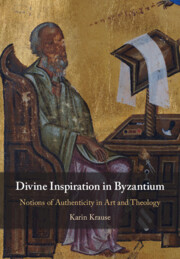Book contents
- Divine Inspiration in Byzantium
- Divine Inspiration in Byzantium
- Copyright page
- Contents
- Plates
- Figures
- Acknowledgements
- Abbreviations
- Introduction
- One The Early Christian Iconography of Divine Inspiration
- Two Inspiration and the Bible in the Post-Iconoclastic Era
- Three Inspiration Continued
- Four Divine Inspiration beyond the Fathers
- Five Inspired Icons
- Six Acheiropoietos
- Seven Allegories of Divine Artistry
- Epilogue
- Bibliography
- Index of Manuscripts
- Index of Biblical Citations
- General Index
- Plate Section (PDF Only)
Six - Acheiropoietos
The Mandylion as “the radiance of God’s glory and exact imprint of God’s very being”
Published online by Cambridge University Press: 16 July 2022
- Divine Inspiration in Byzantium
- Divine Inspiration in Byzantium
- Copyright page
- Contents
- Plates
- Figures
- Acknowledgements
- Abbreviations
- Introduction
- One The Early Christian Iconography of Divine Inspiration
- Two Inspiration and the Bible in the Post-Iconoclastic Era
- Three Inspiration Continued
- Four Divine Inspiration beyond the Fathers
- Five Inspired Icons
- Six Acheiropoietos
- Seven Allegories of Divine Artistry
- Epilogue
- Bibliography
- Index of Manuscripts
- Index of Biblical Citations
- General Index
- Plate Section (PDF Only)
Summary
This chapter takes a fresh look at the ideological and theological significance of the Mandylion of Edessa, an object of unparalleled importance for the religious identity of the Byzantines. Departing significantly from previous scholarship, it argues that the legend of the Mandylion is not about an especially authentic visual portrait of Christ’s face, but rather about Christ as the true image (eikon) of God the Father, understood in a purely ontological sense. Middle Byzantine theological writings about the Mandylion ought also to be read as late contributions to the debate on the legitimacy of visual representations of Christ.
- Type
- Chapter
- Information
- Divine Inspiration in ByzantiumNotions of Authenticity in Art and Theology, pp. 273 - 319Publisher: Cambridge University PressPrint publication year: 2022

